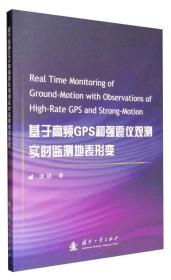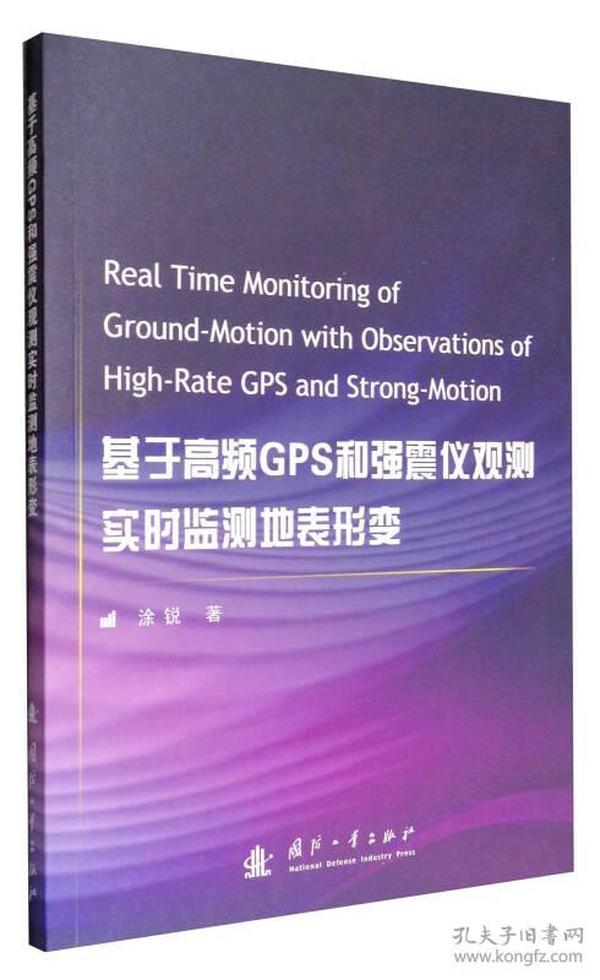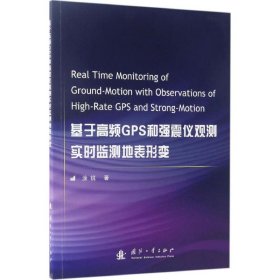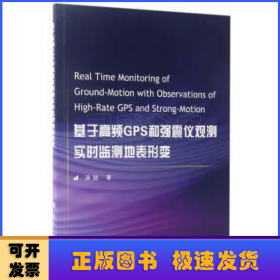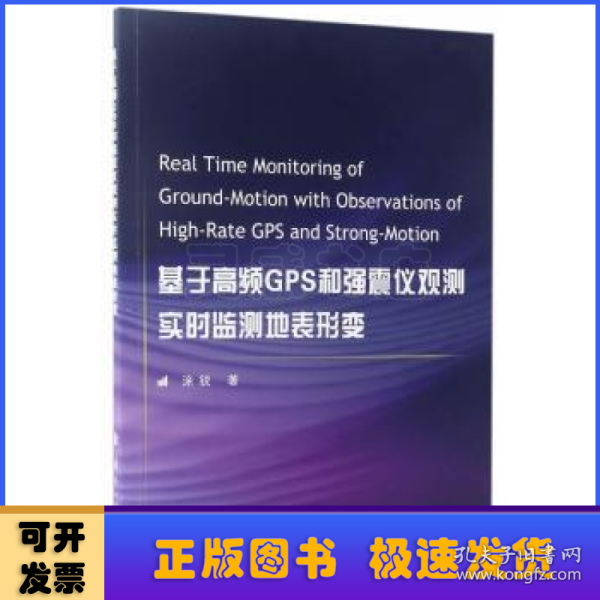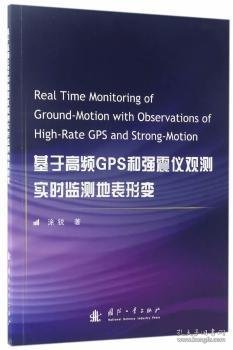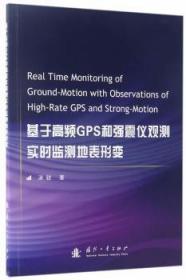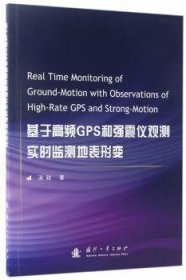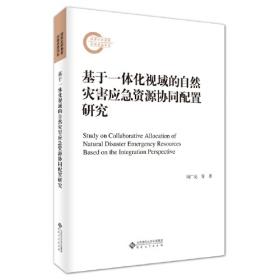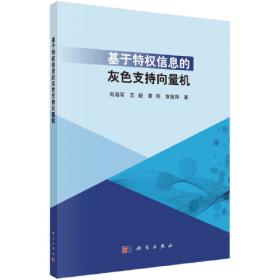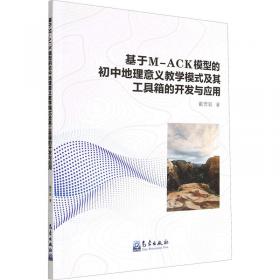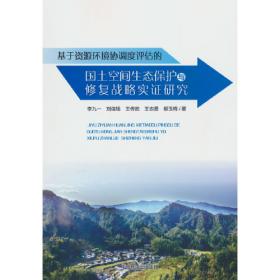基于高频GPS和强震仪观测实时监测地表形变(英文版)
出版时间:
2017-04
版次:
1
ISBN:
9787118111354
定价:
98.00
装帧:
平装
开本:
16开
纸张:
胶版纸
页数:
152页
字数:
195千字
正文语种:
英语
3人买过
-
《基于高频GPS和强震仪观测实时监测地表形变(英文版)》系统地介绍了GPS和强震仪数据融合处理的基本原理和算法模型,主要包括松组合模型、紧组合模型、自适应组合模型、改进的松组合模型、改进的紧组合模型、组合处理中关键技术问题、基线漂移与地表倾斜的关系以及各传感器观测的特点分析等。对GPS测速增强解算和基于联网模式的强震仪基线漂移校正也进行了分析介绍。
《基于高频GPS和强震仪观测实时监测地表形变(英文版)》可供从事GPS灾害监测预警方面的科研、生产人员参考,也可作为高等学校大地测量与地球物理专业的教材使用。 涂锐,男,1985年10月生,湖北浠水人,中国科学院百人计划特任研究员,硕士生导师。2011年获长安大学大地测量专业硕士学位,2014年获德国波茨坦地学中心大地测量专业博士学位,2015年作为引进人才在中科院国家授时中心工作,2016年获中科院百人计划C类(青年俊才)资助。主要从事大地测量与卫星导航方面的科研工作,研究方向包括GNSS多系统组合定位、定轨,GNSS卫星钟差精密求解,GNSS精密授时,GNSS精密单点定位PPP,非差网络RTK,PPP模糊度固定,PPP区域增强定位,GNSS电离层监测建模,GNSS实时快速形变监测,强震仪基线漂移校正,GNSS和地震仪数据融合处理,灾害监测预警等。主持国家留学基金、国家自然科学青年基金、面上基金,中科院百人计划、前沿科技重点研发计划、国家授时中心引进人才项目和陕西省留学回国科技择优支持项目各一项,参与北斗专项中分析中心、星基增强、地基增强系统建设和国家重点研发计划“协同精密定位技术”等多项卫星导航项目。发表学术论文50余篇,其中第1作者论文被SCI收录18篇;授权专利和软件著作权多项;担任多种国际SCI刊源审稿专家。 Chapter 1 Introduction
1.1 Scientific background
1.1.1 GPS solution approaches
1.1.2 Strong-motion data solution approaches
1.1.3 Integration of GPS and accelerometer observations
1.2 Aims and objectives
1.2.1 Augmentation approach
1.2.2 Integration approach
1.2.3 Adaptive approach
1.2.4 The key issues about integration
1.2.5 The relationship between baseline shift and ground tiling
1.3 Organization of the book
Chapter 2 Real-time monitoring the ground motion using GPS with real time corrections
2.1 Introduction
2.2 Methodology
2.2.1 The velocity determination model based on broadcast ephemeris
2.2.2 Extracting corrections from the reference station
2.2.3 The velocity determination model based on reference station correction
2.2.4 Retrieve the final true velocity and displacement
2.2.5 The data processing flow of the augmentation approach
2.3 Experiment analysis
2.3.1 Comparison of displacement and velocity between GPS and strong-motion sensor
2.3.2 Comparison of displacement and velocity results between different sample rate data
2.3.3 Comparison of GPS results between the single station method and augmentation method
2.3.4 Comparison of the observation residuals and initial trend drift correction
2.4 Conclusion
Chapter 3 Application of a net-based baseline correction scheme to strong-motion records of the 2011 Mw 9.0 Tohoku earthquake
3.1 Introduction
3.2 Methodology
3.2.1 Selection of reference records
3.2.2 Net-based correction on target records
3.2.3 Detection of outlier records
3.3 Application to strong-motion data for the 2011 Mw 9.0 Tohoku earthquake
3.3.1 Data
3.3.2 Selected reference records
3.3.3 Augmented target records
3.3.4 Outlier records
3.3.5 Improvements over the previous empirical approaches
3.4 Conclusion and discussion
Chapter 4 Cost-effective monitoring of ground motion related to
earthquakes, landslides or volcanic activity by joint use
of a single-frequency GPS and a MEMS accelerometer
4.1 Introduction
4.2 Method
4.3 Outdoor experiments
4.4 Discussion and conclusions
Chapter 5 A new algorithm for tight integration of real-time GPS
and strong-motion records, demonstrated on simulated,
experimental and real seismic data
5.1 Introduction
5.2 Mathematical model
5.3 A new approach to combine GPS and seismic accelerometer data
5.4 Validation and analysis
5.4.1 Simulated dataset
5.4.2 Experimental Test
5.4.3 Application to a real earthquake : E1 Mayor-Cucapah Mw 7.2, 2010
5.5 Summary and discussion
Chapter 6 Adaptive recognition and correction of baseline shifts from collocated GPS and accelerometer using two phases Kalman filter
6.1 Introduction
6.2 Methodology
6.2.1 The model for tight integration of GPS and strong-motion measurements
6.2.2 The adaptive recognition of baseline shifts in strong-motion records
6.2.3 The implementation process
6.3 Validation
6.3.1 Experimental test using a shaking table
6.3.2 Application to a real earthquake:2011 Mw 9.0 Tohoku earthquake
6.4 Conclusion
Chapter 7 An improved loose integration method of coseismie waves retrieving from collocated GPS and accelerometer
7.1 Introduction
7.2 Overview of the traditional loose integration method
7.3 The improved loose integration method
7.4 Validation and analysis
7.5 Conclusion
Chapter 8 An improved method for tight integration of GPS and strong-motion records: complementary advantages
8.1 Introduction
8.2 Methodology
8.2.1 Using GPS to estimate baseline shifts for the strong-motion sensor
8.2.2 Using acceleration to constrain GPS solution and ambiguity-resolution
8.2.3 The implementation process of the method
8.3 Validations
8.3.1 Analysis of the baseline shift
8.3.2 Analysis of the displacement time series
8.3.3 Analysis of the zenith tropospheric delay
8.3.4 Analysis of the waveforms
8.4 Conclusions and discussions
Chapter 9 The study of key issues about integration of GNSS and strong-motion records for real-time earthquake monitoring
9.1 Introduction
9.2 Method and Data
9.3 Validation and analysis
9.3.1 Coordinate system
9.3.2 GNSS sampling rate
9.3.3 The constrain of the dynamic noises
9.3.4 GNSS data quality
9.3.5 Convergence speed
9.3.6 Ambiguity resolution
9.4 Conclusions and discussions
Chapter 10 The study of baseline shift error in strong-motion and ground tilting during co-seismic period based on GPS observations
10.1 Introduction
10.2 Extracting strong-motion baseline shift based on GPS observation
10.3 Extracting of ground tilting information based on GPS observation
10.4 Validation and analysis
10.4.1 Experiment introduction and data processing
10.4.2 Result analysis
10.4.3 A case study of the earthquake event: 2011 Mw 9.0 Tohoku-Oki earthquake
10.5 Conclusion
Chapter 11 Comparison of high-rate GPS, strong-motion records and their joint use for earthquake monitoring: a ease study of the 2011 nw 9.0 Tohoku earthquake
11.1 Introduction
11.2 Datasets and processing approaches
11.2.1 Data description
11.2.2 Processing approaches
11.3 Results and analysis
11.3.1 Comparison of horizontal co-seismic movement
11.3.2 Comparison in time-frequency domain of the displacement time series
11.3.3 Comparison of velocity waveforms
11.3.4 Comparison of P wave detection
11.4 Conclusions and discussions
Chapter 12 Synthesis
12.1 Conclusions
12.1.1 GPS velocity estimation augmentation approach
12.1.2 Strong-motion net-based augmentation approach
12.1.3 Loose integration of GPS and strong-motion observations
12.1.4 Tight integration of GPS and strong-motion observations
12.1.5 Adaptive integration of GPS and strong-motion observations
12.1.6 Improved loose integration of GPS and strong-motion observations
12.1.7 Improved tight integration of GPS and strong-motion observations
12.1.8 Key issues of integration of GPS and strong-motion observations
12.1.9 Relationship between baseline shifts and ground tilting
12.1.10 Comparison of different sensors for earthquake monitoring and early warning
12.2 Outlook
12.2.1 Study the earthquake early warning model
12.2.2 Study the integration of multi-sensor and data quality control
12.2.3 Develop a new sensor and real-time application system
Acronyms and abbreviations
References
-
内容简介:
《基于高频GPS和强震仪观测实时监测地表形变(英文版)》系统地介绍了GPS和强震仪数据融合处理的基本原理和算法模型,主要包括松组合模型、紧组合模型、自适应组合模型、改进的松组合模型、改进的紧组合模型、组合处理中关键技术问题、基线漂移与地表倾斜的关系以及各传感器观测的特点分析等。对GPS测速增强解算和基于联网模式的强震仪基线漂移校正也进行了分析介绍。
《基于高频GPS和强震仪观测实时监测地表形变(英文版)》可供从事GPS灾害监测预警方面的科研、生产人员参考,也可作为高等学校大地测量与地球物理专业的教材使用。
-
作者简介:
涂锐,男,1985年10月生,湖北浠水人,中国科学院百人计划特任研究员,硕士生导师。2011年获长安大学大地测量专业硕士学位,2014年获德国波茨坦地学中心大地测量专业博士学位,2015年作为引进人才在中科院国家授时中心工作,2016年获中科院百人计划C类(青年俊才)资助。主要从事大地测量与卫星导航方面的科研工作,研究方向包括GNSS多系统组合定位、定轨,GNSS卫星钟差精密求解,GNSS精密授时,GNSS精密单点定位PPP,非差网络RTK,PPP模糊度固定,PPP区域增强定位,GNSS电离层监测建模,GNSS实时快速形变监测,强震仪基线漂移校正,GNSS和地震仪数据融合处理,灾害监测预警等。主持国家留学基金、国家自然科学青年基金、面上基金,中科院百人计划、前沿科技重点研发计划、国家授时中心引进人才项目和陕西省留学回国科技择优支持项目各一项,参与北斗专项中分析中心、星基增强、地基增强系统建设和国家重点研发计划“协同精密定位技术”等多项卫星导航项目。发表学术论文50余篇,其中第1作者论文被SCI收录18篇;授权专利和软件著作权多项;担任多种国际SCI刊源审稿专家。
-
目录:
Chapter 1 Introduction
1.1 Scientific background
1.1.1 GPS solution approaches
1.1.2 Strong-motion data solution approaches
1.1.3 Integration of GPS and accelerometer observations
1.2 Aims and objectives
1.2.1 Augmentation approach
1.2.2 Integration approach
1.2.3 Adaptive approach
1.2.4 The key issues about integration
1.2.5 The relationship between baseline shift and ground tiling
1.3 Organization of the book
Chapter 2 Real-time monitoring the ground motion using GPS with real time corrections
2.1 Introduction
2.2 Methodology
2.2.1 The velocity determination model based on broadcast ephemeris
2.2.2 Extracting corrections from the reference station
2.2.3 The velocity determination model based on reference station correction
2.2.4 Retrieve the final true velocity and displacement
2.2.5 The data processing flow of the augmentation approach
2.3 Experiment analysis
2.3.1 Comparison of displacement and velocity between GPS and strong-motion sensor
2.3.2 Comparison of displacement and velocity results between different sample rate data
2.3.3 Comparison of GPS results between the single station method and augmentation method
2.3.4 Comparison of the observation residuals and initial trend drift correction
2.4 Conclusion
Chapter 3 Application of a net-based baseline correction scheme to strong-motion records of the 2011 Mw 9.0 Tohoku earthquake
3.1 Introduction
3.2 Methodology
3.2.1 Selection of reference records
3.2.2 Net-based correction on target records
3.2.3 Detection of outlier records
3.3 Application to strong-motion data for the 2011 Mw 9.0 Tohoku earthquake
3.3.1 Data
3.3.2 Selected reference records
3.3.3 Augmented target records
3.3.4 Outlier records
3.3.5 Improvements over the previous empirical approaches
3.4 Conclusion and discussion
Chapter 4 Cost-effective monitoring of ground motion related to
earthquakes, landslides or volcanic activity by joint use
of a single-frequency GPS and a MEMS accelerometer
4.1 Introduction
4.2 Method
4.3 Outdoor experiments
4.4 Discussion and conclusions
Chapter 5 A new algorithm for tight integration of real-time GPS
and strong-motion records, demonstrated on simulated,
experimental and real seismic data
5.1 Introduction
5.2 Mathematical model
5.3 A new approach to combine GPS and seismic accelerometer data
5.4 Validation and analysis
5.4.1 Simulated dataset
5.4.2 Experimental Test
5.4.3 Application to a real earthquake : E1 Mayor-Cucapah Mw 7.2, 2010
5.5 Summary and discussion
Chapter 6 Adaptive recognition and correction of baseline shifts from collocated GPS and accelerometer using two phases Kalman filter
6.1 Introduction
6.2 Methodology
6.2.1 The model for tight integration of GPS and strong-motion measurements
6.2.2 The adaptive recognition of baseline shifts in strong-motion records
6.2.3 The implementation process
6.3 Validation
6.3.1 Experimental test using a shaking table
6.3.2 Application to a real earthquake:2011 Mw 9.0 Tohoku earthquake
6.4 Conclusion
Chapter 7 An improved loose integration method of coseismie waves retrieving from collocated GPS and accelerometer
7.1 Introduction
7.2 Overview of the traditional loose integration method
7.3 The improved loose integration method
7.4 Validation and analysis
7.5 Conclusion
Chapter 8 An improved method for tight integration of GPS and strong-motion records: complementary advantages
8.1 Introduction
8.2 Methodology
8.2.1 Using GPS to estimate baseline shifts for the strong-motion sensor
8.2.2 Using acceleration to constrain GPS solution and ambiguity-resolution
8.2.3 The implementation process of the method
8.3 Validations
8.3.1 Analysis of the baseline shift
8.3.2 Analysis of the displacement time series
8.3.3 Analysis of the zenith tropospheric delay
8.3.4 Analysis of the waveforms
8.4 Conclusions and discussions
Chapter 9 The study of key issues about integration of GNSS and strong-motion records for real-time earthquake monitoring
9.1 Introduction
9.2 Method and Data
9.3 Validation and analysis
9.3.1 Coordinate system
9.3.2 GNSS sampling rate
9.3.3 The constrain of the dynamic noises
9.3.4 GNSS data quality
9.3.5 Convergence speed
9.3.6 Ambiguity resolution
9.4 Conclusions and discussions
Chapter 10 The study of baseline shift error in strong-motion and ground tilting during co-seismic period based on GPS observations
10.1 Introduction
10.2 Extracting strong-motion baseline shift based on GPS observation
10.3 Extracting of ground tilting information based on GPS observation
10.4 Validation and analysis
10.4.1 Experiment introduction and data processing
10.4.2 Result analysis
10.4.3 A case study of the earthquake event: 2011 Mw 9.0 Tohoku-Oki earthquake
10.5 Conclusion
Chapter 11 Comparison of high-rate GPS, strong-motion records and their joint use for earthquake monitoring: a ease study of the 2011 nw 9.0 Tohoku earthquake
11.1 Introduction
11.2 Datasets and processing approaches
11.2.1 Data description
11.2.2 Processing approaches
11.3 Results and analysis
11.3.1 Comparison of horizontal co-seismic movement
11.3.2 Comparison in time-frequency domain of the displacement time series
11.3.3 Comparison of velocity waveforms
11.3.4 Comparison of P wave detection
11.4 Conclusions and discussions
Chapter 12 Synthesis
12.1 Conclusions
12.1.1 GPS velocity estimation augmentation approach
12.1.2 Strong-motion net-based augmentation approach
12.1.3 Loose integration of GPS and strong-motion observations
12.1.4 Tight integration of GPS and strong-motion observations
12.1.5 Adaptive integration of GPS and strong-motion observations
12.1.6 Improved loose integration of GPS and strong-motion observations
12.1.7 Improved tight integration of GPS and strong-motion observations
12.1.8 Key issues of integration of GPS and strong-motion observations
12.1.9 Relationship between baseline shifts and ground tilting
12.1.10 Comparison of different sensors for earthquake monitoring and early warning
12.2 Outlook
12.2.1 Study the earthquake early warning model
12.2.2 Study the integration of multi-sensor and data quality control
12.2.3 Develop a new sensor and real-time application system
Acronyms and abbreviations
References
查看详情
-
九五品
北京市房山区
平均发货19小时
成功完成率73.17%
-
全新
北京市房山区
平均发货28小时
成功完成率83.73%
-
九五品
北京市东城区
平均发货22小时
成功完成率66.67%
-
全新
广东省广州市
平均发货20小时
成功完成率86.5%
-
全新
北京市朝阳区
平均发货19小时
成功完成率84.96%
-
全新
上海市黄浦区
平均发货11小时
成功完成率94.48%
-
全新
北京市丰台区
平均发货8小时
成功完成率90.4%
-
全新
北京市通州区
平均发货9小时
成功完成率88.67%
-
全新
山东省泰安市
平均发货18小时
成功完成率92.38%
-
全新
北京市朝阳区
平均发货14小时
成功完成率85.41%
-
全新
北京市丰台区
平均发货17小时
成功完成率69.38%
-
九五品
重庆市万州区
平均发货6小时
成功完成率95.92%
-
全新
河北省保定市
平均发货9小时
成功完成率87.78%
-
全新
河北省保定市
平均发货32小时
成功完成率60.71%
-
全新
广东省广州市
平均发货9小时
成功完成率87.58%
-
全新
河北省保定市
平均发货23小时
成功完成率78.42%
-
全新
河北省保定市
平均发货37小时
成功完成率51.67%
-
全新
上海市浦东新区
平均发货20小时
成功完成率80.16%

 占位居中
占位居中


